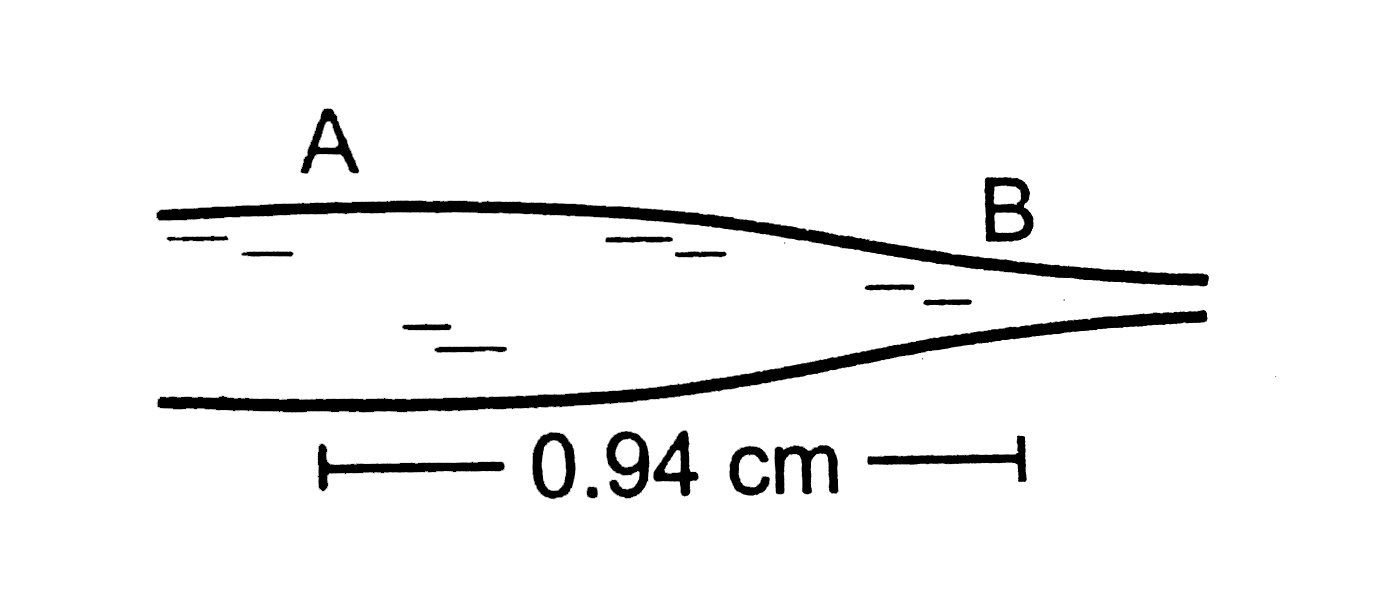Suppose the tube in the previous problem is kept verticla with B upward. Water enters through B at the rate of . Repeat parts a, b, and c. Note that the speed decreases as the water falls down.Solution in Tamil
The correct Answer is:A, B, C
a.
1/2pv_B^2+rhogh_B+p_B=1/2pv_A^2+rhogh_A+p_Ararr P_A-P_B=1/2xx1xx1875+1/2xx1000x15/16=1875Dyne/cm^2=188N/m^2
Topper's Solved these Questions
Similar Questions
Find the accelerationof the moon with respect to the eath from the following data, Distance between the earth and the moon =3.85×105 km and the time taken by the moon to complete one revolution around the earth =27.3days
09:53View SolutionA body slipping on a rough horizontal plane moves wioth a deceleationof 4.0ms. What is cofficient of kineic friction between the block and the plane?
03:29View SolutionSuppose the entire system of the previous question is kept inside an elevator which is coming down with an acceleration altg. Repeat parts a. and b.
05:25View SolutionWater enters through end A with a speed v1 and leaves through end B with a speed v2 of cylindrical tube AB. The tube is always completely filled with water. In case I the tube is horizontal, in case II it vertical with the end A upward and in case III it is vertical with the end B upward. We have v1=v2for
06:03View SolutionWaster flows throgh a horizontal tube of variable cross section.The area of cross section at A and B are 4 mm2and2mm2 respectively. If 1 cc of water enters per seconds through. A find a. The speed of water at A, b. the speed of river at B and c. the pressure difference PA−PB.
 05:05View Solution
05:05View SolutionSuppose the tube in the previous problem is kep vertical with A upward but the other conditions remain the same. The separation between the cross sections at A and B is 15/16 cm. Repeat parts a., b, and c of the previous problem. takeg=10ms−2.
02:40View SolutionWater flows through a tube shown in figure. The areas of cross section at A and B are 1cm2and0.5cm2 respectively. The height difference between A and B is 5m. If the speed of water at A is 10 cms−1 find a the speed at B and b the difference in pressures at A and B.
 View Solution
View SolutionSuppose the 19Ω resistor of the previous problem is disconnected. Find the current through P2Q2 in the two situations (a) and (b) of that problem.
06:32View Solutionमान ले कि प्रश्न 2 कि नली को उलट दिया जाता है । जिससे B ऊपर और A नीचे हो जाता है ।पानी B से A कि ओर बहता है । (a ) , (b ) तथा ( c ) भागो के उत्तर दे । ध्यान दे कि पानी का वेग नीचे आने पर घट जाता है ।
06:21View SolutionWater flows through a horizontal tube of variable cross-section. The area of cross section at A and B are 4mm2and2mm2 respectively. If 1 cc of water enters per seconds through. A find a. The speed of water at A, b. the speed of river at B and c. the pressure difference PA−PB.
 03:11View Solution
03:11View SolutionWater flows through a tube shown in figure. The areas of cross section at A and B are 1cm2and0.5cm2 respectively. The height difference between A and B is 5cm. If the speed of water at A is 10 cms−1. Find a. the speed at B and b. the difference in pressures at A and B.
 06:01View Solution
06:01View SolutionSuppose the 19Ω resistor of the previous problem is disconnected. Find the current through P2Q2 in the two situations (a) and (b) of that problem.
04:27View SolutionWater enters through end A with a speed v_1 and leaves through end B with a speed v_2 of cylindrical tube AB. The tube is always completely filled with water. In case I the tube is horizontal, in case II it vertical with the end A upward and in case III it is vertical with the end B upward. We have v_1=v_2 for
04:26View SolutionWater flows through a tube shown in figure. The areas of cross section at A and B are 1cm2and0.5cm2 respectively. The height difference between A and B is 5m. If the speed of water at A is 10 cms−1 find
a) the speed at B.
b) the difference in pressures at A and B.
 03:46View Solution
03:46View SolutionWater flows through a horizontal tube of variable cross section.The area of cross section at A and B are 4 mm2and2mm2 respectively. If 1 cc of water enters per second through A find
a) The speed of water at A
b) the speed of river at B
c) the pressure difference PA−PB.
 03:53View Solution
03:53View SolutionSuppose the 19Ω resistor of the previous problem is disconnected. Find the current through P2Q2 in the two situations (a) and (b) of that problem.
View Solution

